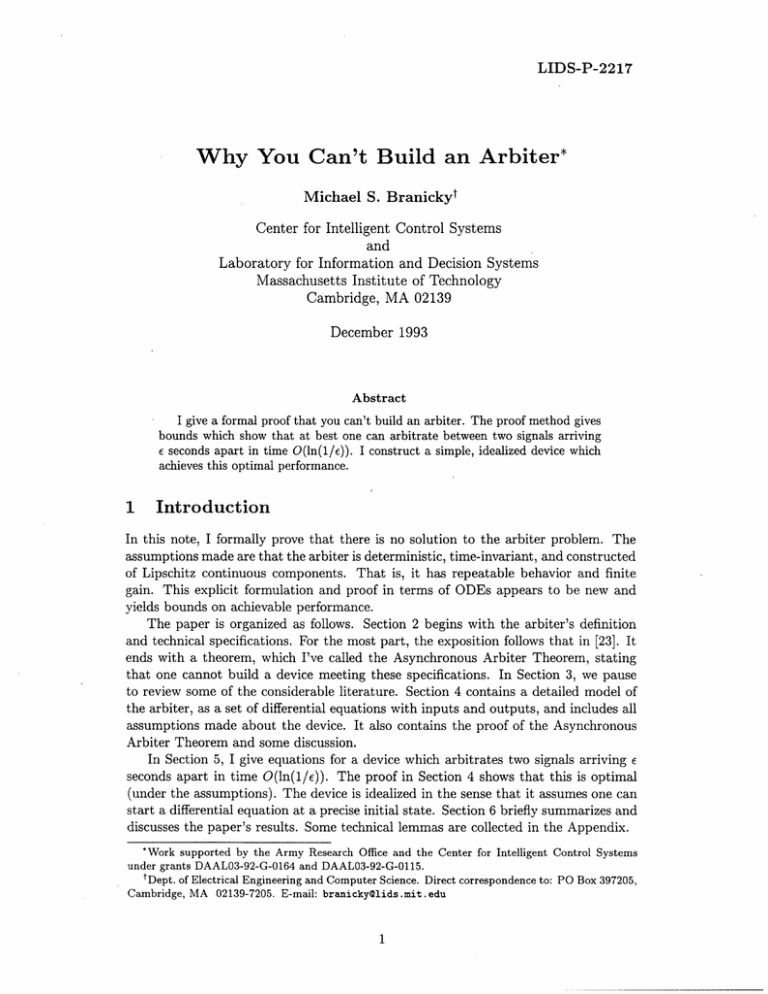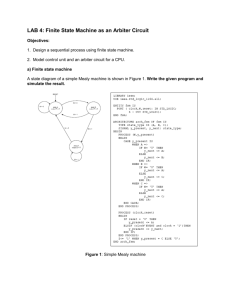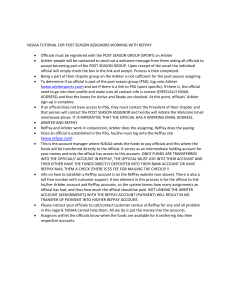Why You Can't Build an Arbiter*
advertisement

LIDS-P-2217
Why You Can't Build an Arbiter*
Michael S. Branickyt
Center for Intelligent Control Systems
and
Laboratory for Information and Decision Systems
Massachusetts Institute of Technology
Cambridge, MA 02139
December 1993
Abstract
I give a formal proof that you can't build an arbiter. The proof method gives
bounds which show that at best one can arbitrate between two signals arriving
e seconds apart in time O(ln(1/e)). I construct a simple, idealized device which
achieves this optimal performance.
1
Introduction
In this note, I formally prove that there is no solution to the arbiter problem. The
assumptions made are that the arbiter is deterministic, time-invariant, and constructed
of Lipschitz continuous components. That is, it has repeatable behavior and finite
gain. This explicit formulation and proof in terms of ODEs appears to be new and
yields bounds on achievable performance.
The paper is organized as follows. Section 2 begins with the arbiter's definition
and technical specifications. For the most part, the exposition follows that in [23]. It
ends with a theorem, which I've called the Asynchronous Arbiter Theorem, stating
that one cannot build a device meeting these specifications. In Section 3, we pause
to review some of the considerable literature. Section 4 contains a detailed model of
the arbiter, as a set of differential equations with inputs and outputs, and includes all
assumptions made about the device. It also contains the proof of the Asynchronous
Arbiter Theorem and some discussion.
In Section 5, I give equations for a device which arbitrates two signals arriving e
seconds apart in time O(ln(1/e)). The proof in Section 4 shows that this is optimal
(under the assumptions). The device is idealized in the sense that it assumes one can
start a differential equation at a precise initial state. Section 6 briefly summarizes and
discusses the paper's results. Some technical lemmas are collected in the Appendix.
*Work supported by the Army Research Office and the Center for Intelligent Control Systems
under grants DAAL03-92-G-0164 and DAAL03-92-G-0115.
tDept. of Electrical Engineering and Computer Science. Direct correspondence to: PO Box 397205,
Cambridge, MA 02139-7205. E-mail: branicky0lids.mit.edu
2
The Problem
The definition and technical specifications of the arbiter below are adapted from [23].
An arbiteris a device that can be used to decide the winner of two-person races.
It is housed in a box with two input buttons, labeled Bo and B 1, and two output lines,
W0 and W 1 , that can each be either 0 or 1. For ease of exposition, let the vectors
B = (Bo,B 1 ),
W = (Wo,W
1)
denote the button states and outputs, respectively. There is also a reset button. After
pressing the reset button, the output should be (1,0) if Bo is pressed before B 1; it
should be (0, 1) if B 1 is pressed before Bo.
Let Ti denote the time that button Bi is pressed. Basically, the function of the
arbiter is to make a binary choice based on the value of the continuous variable To - T 1 .
If the difference is negative, the output should be (1,0); if it is positive, the output
should be (0, 1). Upon reset, the output is set to (0, 0).
Now, here are the arbiter's technical specifications:
S1. The reset button causes the output to become (0, 0), perhaps after waiting for
some specified time, where it remains until one or both buttons are pressed.
S2. The pressing of either or both buttons causes, after an interval of at most Td
units, the output to be either (0, 1) or (1, 0); the output level persists until the
next reset input.
S3. If Bo is pressed Ta seconds or more before B 1 is pressed, then the output will be
(1, 0), indicating that Bo was pressed first. Similarly, if B 1 is pressed Ta seconds
or more before Bo is pressed, then the output will be (0, 1), indicating that B 1
was pressed first.
S4. If Bo and B 1 are pressed within Ta seconds of each other, then the output is
either (1,0) or (0, 1)-one does not care which-after the Td-second interval.
Problem 1 (Asynchronous arbiter problem.) Construct an absolutely reliable arbiter that meets the specifications S1-S4.
In the next section, I prove that there is no solution to Problem 1:
Theorem 2 (Asynchronous arbiter theorem.) For no choice of the values for Ta
and Td is it possible to construct an absolutely reliable arbiter that meets the specifications S1-S4.
3
Previous Work
The arbiter problem or mutual exclusion problem is a cult problem in computer science. The problem also appears in building synchronizers and latches. See [19, 5]
and their references for a history of these so-called "glitch" problems. See [2] for the
equivalence of these and other digital circuit problems.
The problem has generated a lot of literature and many proofs that one cannot be
built. Still, there are those who are pretty sure you can't build one, but believe that
there must be some trick by which they could build one.
2
Many of the proofs available in the literature come down to an intermediate value
argument. More precisely, to the topological fact that one cannot have continuous
maps with a connected domain and a disconnected range [16]. (For briefness, we will
refer to this below as the connectedness law.) The works [9, 14, 10, 11] fall into this
category. However, researchers still question the way the modeling of inputs. For
example, [11] responds to [14] by saying that "[Marino] requires to be included in
the input function space, functions with unbounded or undefined second derivatives.
Without these functions, his theorem cannot guarantee that metastable behavior can
occur." They then go on to prove that metastable behavior is still unavoidable if one
restricts the inputs to be more "practical." However, even this does not satisfy the
critics. Some assert that one can add some kind of "metastability detector" to get
around these problems [18].
In [13], it is shown using index theory that metastable states must exist in an R-S
latch with state space LR2. He correctly asserts that such states are at the heart of
the arbiter problem. But later, he says that the only way to avoid this is to assure
that all pulses are "long enough; the only way this seems possible is by feedback links
which report the occurrence of transitions to the sender" [13, p. 79]. However, if one
had access to a device which could report transitions, then one could trivially solve
the arbiter problem!
Many people take it for granted that the connectedness law itself is a proof of the
inability to build arbiters. For example, the "proof" in [23, p. 94] simply says
In order to understand why the arbiter is unrealizable, we must recognize
that we have introduced continuous variables-the times at which the buttons are pressed-into our discrete model. Let to and tl be the times at
which Bo and B 1, respectively, are pressed. Then the function of the of
the arbiter is to make a binary choice (Wo or W1 ) based on the value of
the continuously variable to - tl: If the difference is negative, Wo is to be
1 and W1 is to be 0; otherwise Wo is to be 0 and W 1 is to be 1.
This is not much more than restatement of the problem. Moreover, one cannot invoke
the connectedness law (which is not stated in [23]) so easily. One must prove that the
map given by the device is indeed continuous before one makes such an appeal. This
is not trivial since one has, at heart, a "discrete model." One must explicitly rule out
the possibility that this "discrete model" introduces any discontinuities. Indeed, in [3]
we easily show that some reasonable models for describing the interaction of discrete
and continuous variables [4, 21, 1, 17] can implement reliable arbiters.
In [15], they show that arbiters cannot act correctly even in unbounded time. This
can be related to our result in Section 5 by the fact that one cannot start the differential
equation at exactly zero. Thus there will be some input signals which cause the device
to directly hit a metastable equilibrium point, staying there for all future time. Indeed,
if the signals arrive at exactly the same time our simple device will still stay at the
origin for unbounded time. Similarly, this trivial statement can be deduced whenever
metastable states exist. While these statements are true mathematically under their
assumptions, one wonders about the practicality of such statements, given that real
devices are subject to a small amount of noise.
Practically, also, one should note that the problem does not arise in synchronous
situations, since the input space is then disconnected. One can achieve arbitrarily low
synchronization failure rates in these cases [20].
3
4
The Proof
First, a more detailed model of the arbiter is required. The assumptions are as follows:
Al. The arbiter's components are physical devices having finite gain: satisfying Lipschitz continuity.
A2. The arbiter is of finite size.
A3. The arbiter's behavior is experimentally repeatable. That is, it is time-invariant
and deterministic.
The arbiter will be modeled as a system of ordinary differential equations with
inputs and outputs as follows:
i(t) = f(x(t),B(t)),
W(t) = h(x(t))
x(O) E h-1((0,0))
where x(t) E R n , W(t) E R 2 , B(t) E {0, 1}2, with B(.) left-continuous. Each f(., B),
B E {0, 1}2, is a globally Lipschitz map. Thus, each vector field f(-, B) defines a
global flow JR x R n -+ R n : (t,x) -+ (B ,B
1 2)()((x), where {b(Bl,B 2)(t)lt E R} is the
group of C' diffeomorphisms of R n with infinitesimal generator f(., B1, B 2 ). Further,
h : R n -+ R 2 is globally Lipschitz continuous, with constant Lw, from norm 1 1on
R" to the Euclidean norm {. {{on R2.
Note Lw > 0 since h is not a constant, having (0, 0), (1, 0), and (0, 1) in its image.
Note also that the action of the reset button is unmodeled; it is not necessary to the
proof.
Next, some notation. Let . { denote both an arbitrary norm on Rn and absolute
value in JR, the meaning being clear from usage. For ease of exposition, let Ft, Gt, Ht
denote the fundamental solutions (0o,l) (t), q5(1,0 ) (t), and (1,l)(t), respectively. Also let
L > 0 denote a positive, finite bound of the maximum of the four Lipschitz constants
corresponding to each of the f(., B).
Now, I am ready to settle the arbiter problem.
Proof [of Theorem 2] The proof is by contradiction, assuming an arbiter can be
built which satisfies the above assumptions.
Assume that the arbiter has been reset, is in state x(0) = xo at time t = 0 with
h[xo] = (0, 0), and that one of the buttons is pressed at time t = 0.1 Also, assume that
the reset button is not pressed until some time TR > Ta + Td. The behavior of the
device from t = 0 to t = TR is completely determined by which button was pressed
first and at what time the second button is pressed (if ever). Therefore, let xp(t)
denote the solution at time t of Equation (1) starting at time t = 0 at state x(0) = xo
with fixed parameter p = To- T1. Thus, p represents the difference between the times
when Bo and B1 are pressed. If Bo is pressed but B1 is never pressed, set p = oo. If
B1 is pressed but Bo is never pressed, set p = -oo.
The arbiter specifications require that for Ta + Td < t < TR,
h[xp(t)] =
1
(1,0),
-T
P<
p
(0,1),
(1,0) or (0,1),
otherwise
>T
This is without loss of generality as the arbiter equations are time-invariant.
4
These specifications and Lemma 42 are such that for any 6 > 0, one can find -Ta <
a < < Ta, with r- a < 6, and with one of h[x,(Ta + Td)], h[Xr(Ta + Td)] equal to
(1, 0) and the other equal to (0, 1).
Now, pick 6 < min{Ta, Td, 1/L} and
c = max {lf(xo, 1,0)1, If(xo,O, 1)1, If(xo, 1, 1)1}
Note c > 0, for otherwise h[x,(t)] = h[x,(t)] = h[xo] for all 0 < t < TR, a contradiction. Finally, for ease of notation, define Xt = x,(t) and Yt = x,(t). Note that
Xo = Yo = xo.
The proof splits into three cases:
1. 0 <a <
< Ta.
2. -Ta <a
< r < 0.
3. -T, < a < O<
< Ta.
Case 1. In this case,
Xt
=
Ft (xo) ,
<t <
Ht-(F(xo)), a < t < TR
0 < t <r
- < t < TR
Ft(zo),
Ht-(F, (xo)),
Yt
t
Thus, X, = Ya. Now, by Corollary 6
IY - YI[ < cL- 1(eL _- eLT )
Thus, Lemma 7 gives
IXa+rd - Y,+Tdl
<
cL-l(eL(r-a) _ l)eLaeLTd
<
cL-l(e
<
c6(e - l)eL(Ta+Td)
L -
l1)eL(Ta+Td)
where the last line follows from L6 < 1. But,
v = llh [Xa+Td]- h [YT+Tdll < Lw
IX+rTd -
YT+TdI
yielding
K
clef
cLw(e-
V/_
_
_
1)eL(Ta+Td)
<6
Case 2. The argument is similar to Case 1 and yields the same inequality on 6.
Case 3. In this case,
Xt
Yt
2
=
O < t <
Gt(xo),
{
H-lIlj(Glal(xo)),
xFt(xo),
Ht-,(Fr(xo)),
0 <t <T
r < t < TR
Referenced lemmas and corollaries appear in the Appendix.
5
ail< t < TR
(2)
Note that max{(la, ITI} < 6. This and Lemma 5 give
|XI-l
IYJ < XI 1 -
+
0o lY,
-
xo < 2cLl(eLS
-
1)
Thus, Lemma 7 gives
< 2cL(eL
XIaI+Td-YT±d I
<
l)eLTd
2ceLTd(e - 1)6
where the last line follows from L6 < 1 and, again,
d
= h [XII+±Td] -h [Yr+Tdll
< LW XIITd-Y+Td
-
so
K3
1
/2 cLw(e -
<6
)eLTd -
(3)
Thus, choosing 6 < min{Ta, Td, 1/L, K1, K3} would have achieved a contradiction
in all three cases.
o
The basic argument used above is that one cannot have a continuous map from a
connected space (e.g., R. containing p) to a disconnected space (e.g., {(1,0), (0,1)})
[16]. Thus, the impossibility remains if one assumes a nondeterministic arbiter acting
as follows: Produce an intermediate output of (1, O0)or (0, 1) as before, along with the
new possibility of (a, b), some other distinguishable state, meaning "I don't know,"
"flip a coin," or "invoke metastability detector."
I have just demonstrated explicitly the continuity of the system of switched differential equations modeling the arbiter. But the explicit proof yields bounds on arbiter
behavior. Specifically, while the proof prohibits the construction of an arbiter with
Td = 0(1), it does not prohibit an arbitration device with Td = O(ln(1/p)). I construct
such a device in the next section.
Note that the inputs B are assumed to be ideal in the sense that they switch from
0 to 1 instantaneously. Imposing continuity assumptions on B as signals in [0, 1]2
would lead to a similar result.
5
An Optimal Arbitration Device
The inequalities (2) and (3) derived in the last section show that it is impossible to
build an arbiter with constant Td. However, these inequalities do not prohibit one's
building a device with Td = O(ln(1/6)). In particular, plugging in
Td = L -
where
K>max
1
ln(K/6)
{cLw(e--
1)eLTa' cLw(e--1)v }
satisfies them, showing the possibility of a device which arbitrates between two signals
arriving within time e of each other in time Td = O(ln(1/e)). Such a device exists.
6
The device is given by the following equations
x(t)
W(t)
= f(x(t),B(t)),
= h(x(t))
x(O) = 0
where x(t) E R and
f(x,o,o)
= o
f(x,0,1)
=
-1
f(x,1,0)
=
1
f(x,1,1)
=
Lx
and
h(x) =
(0 1),
x <-I
(0, 21x1-1),
-11 < x < -1/2
(0, 0),
-1/2 < x < 1/2
(2x-1,0),
1/2_<x_<1
(1,0),
1< x
Theorem 3 The device described above can arbitrate between two signals arriving
within time 0 < e of each other in time Td = O(ln(1/e)).
Proof
Then
Assume that Bo is pressed at time t = 0 and B 1 is pressed at time t = e.
x(t)
=
{ eL(t-),
e< t
A simple calculation shows that x(t) > 1 for
t > max{L- 1 ln(1/e), 0} + 1
The argument for B 1 pressed before Bo is similar.
[]
Note that the device has no reset button. The assumption that one can somehow
set x(0) = 0 is implicit. Clearly, this is a device that is not immune to noise.
6
Conclusions
In this note, I have formally proven that there is no solution to the arbiter problem.
The assumptions made were that the arbiter is deterministic, time-invariant, and
constructed of Lipschitz continuous components. That is, it has repeatable behavior
and finite gain.
The same arguments hold even if one is to produce an intermediate output of (1, 0)
or (0, 1) as before, along with the new possibility of (a, b), some other distinguishable
state, meaning "I don't know," "flip a coin," or "invoke metastability detector." Thus
the proof disallows practical devices using ternary logic [22].
Moreover, the proof does not depend on the fact that the inputs Bi are assumed
to be ideal in the sense that they switch from 0 to 1 instantaneously. It holds in spite
of this. Imposing continuity assumptions on B as signals in [0, 1]2 leads to a similar
result.
7
The explicit formulation and solution of the arbiter problem in terms of ODEs
appears to be new and yields bounds on achievable performance in terms of "circuit
gain." Thus, the result should be useful to circuit designers.
In [7, 12], the authors give ODEs for CMOS synchronization circuits; [7] studies
the linearized equations, while [12] studies the full nonlinear equations. It would
be interesting to compare this practical characterization of metastability against our
theoretical bounds. This is the subject of future research.
Acknowledgements
In his course at MIT John Wyatt [24] presented the arbiter problem and the challenge
to produce an ODE-based model and proof. This report is the answer to that challenge.
This work was supported by the Army Research Office and the Center for Intelligent Control Systems under contracts DAAL03-92-G-0164 and DAAL03-92-G-0115.
Appendix
Lemma 4 If X is a connected metric space, Y is a discrete topological space with two
points, and f X -+ Y is surjective, then for every 6 > 0 one can find x, z E X such
that d(x, z) < 6 and f(x) : f(z).
Proof Assume the contrary. Then for all x e X, f(Bs(x)) = {f(x)} C V, where
Bj(x) denotes the ball of radius 3 about x and V is any open set about f(x) in Y.
Thus, f is continuous [16]. But f continuous and X connected implies f(X) = Y is
connected [16], a contradiction.
[
Lemma 5 Suppose
x(t) = f(x(t))
with f globally Lipschitz continuous in x with constant Lf > O. Then, for any L such
that L > Lf and L > 0, and any t 2 > t1 ,
xt 2 -
Proof
Xtl
I < If(xtl) IL-1 (eL(t2- t )
-
1)
Note that for t > t1 ,
Xt
- Xt =
f (xtl)ds +
[f/(x)
- f (tl)]ds
So that
t
Ixt - xtl _<
t
If(xtl) ds +
If(xs) -f(xt,)lds
< (t- ti)lf(xtl)l +
Lxs - xtlds
Now, substituting r = t - tl and a = s - t1 , this becomes
1X+tl - Xt I < If (Xtl )I +
8
ALlxo+tl
- xtl Ida
Finally, defining u(r) = IxT+tl-xtl
, this becomes
u(T) _< rf(xt,)l +
j
Lu(o)dc
The result now follows from the well-known Bellman-Gronwall inequality [6, p. 252].
Corollary 6 Under the same assumptions plus the fact that the system was in state
Xto at time to < tl < t 2,
Ixt2 - xtl I
Proof
If(xto) IL- (eL(t2 -t 0)
eL(ti - t o))
Note that Lipschitz continuity gives
If(xt )IL Llxt - xtol + If(xto)l
But, the lemma gives in turn
Ixt, - Xto I < If(xto)L- (eL(tl-to)
- 1)
So that the result follows.
The following lemma is well-known (see, e.g., [8, p. 169]).
El
Lemma 7 Let y(t), z(t) be solutions to
x = f (x)
where f has global Lipschitz constant L > O. Then for all t > to,
jy(t) - z(t)j < Iy(to) - z(to)leL(t-
t°)
References
[1] ALLEN BACK, JOHN GUCKENHEIMER, AND MARK MYERS. A dynamical simu-
lation facility for hybrid systems. Technical Report 92-6, Mathematical Sciences
Institute, Cornell University, April 1992. Revised.
[2] JosEi C. BARROS AND BRIAN W. JOHNSON. Equivalence of the arbiter, the
synchronizer, the latch, and the inertial delay. IEEE Transactions on Computers,
C-32(7):603-614, July 1987.
[3] MICHAEL S. BRANICKY. Universal computation and other capabilities of hybrid
and continuous dynamical systems. Technical Report LIDS-P-2218, Laboratory
for Information and Decision Systems, Massachusetts Institute of Technology,
December 1993.
[4] ROGER W. BROCKETT. Hybrid models for motion control systems. Technical Report CICS-P-364, Center for Intelligent Control Systems, Massachusetts Institute
of Technology, March 1993.
9
[5] THOMAS J. CHANEY AND CHARLES E. MOLNAR. Anomalous behavior of syn-
chronizer and arbiter circuits. IEEE Transactions on Computers, pages 421-422,
April 1973.
[6] CHARLES A. DESOER AND MATHUKUMALLI VIDYASAGAR.
Feedback Systems:
Input-Output Properties. Academic Press, New York, NY, 1975.
[7] STEPHEN T. FLANNAGAN.
Synchronization reliability in CMOS technology.
IEEE Journal of Solid-State Circuits, SC-20(4):880-882, August 1985.
[8] MORRIS W. HIRSCH AND STEPHEN SMALE. Differential Equations, Dynamical
Systems, and Linear Algebra. Academic Press, Inc., San Diego, CA, 1974.
[9] MARCO HURTADO. Structure and Performance of Asymptotically Bistable Dynamical Systems. PhD thesis, Washington University, St. Louis, 1975.
[10] MARCO HURTADO AND DAVID L. ELLIOTT. Ambiguous behavior of logic bistable
systems. In Proc. 13th Allerton Conference Circuit and Systems Theory, pages
605-611, October 1975.
[11] LINDSAY KLEEMAN
AND ANTONIO CANTONI.
On the unavoidability of
metastable behavior in digital systems. IEEE Transactions on Computers, C36(1):109-112, January 1987.
[12] J. L. KRYSL AND S. M. KANG. The metastable properties and optimization of
CMOS memory devices. Coordinated Science Laboratory, University of Illinois
at Urbana-Champaign, Pre-print, 1985.
[13] RICHARD K. LEWIS. Switching dynamics. Technical Report 4675, California
Institute of Technology, October 1981.
[14] LEONARD R. MARINO. General theory of metastable operation. IEEE Transac-
tions on Computers, C-30(2):107-115, 1981.
[15] MICHAEL MENDLER AND TERRY STROUP. Newtonian arbiters cannot be proven
correct. In J. Staunstrup and R. Sharp, editors, Designing Correct Circuits,pages
47-66. Noth-Holland, Amsterdam, 1992.
[16] JAMES R. MUNKRES. Topology. Prentice-Hall, 1975.
[17] ANIL NERODE AND WOLF KOHN. Models for hybrid systems: Automata, topolo-
gies, stability. Technical Report 93-11, Mathematical Sciences Institute, Cornell
University, March 1993. Revised.
[18] M. P9CHOU6EK. Anomalous response times of input synchronizers. IEEE Transactions on Computers, C-25(2):133-139, February 1976.
[19] CHARLES L. SEITZ. Ideas about arbiters. Lambda, First Quarter:10-14, 1980.
[20] WILLIAM K. STEWART AND STEPHEN A. WARD. A solution to a special case
of the synchronization problem. IEEE Transactions on Computers, C-37(1):123125, January 1988.
10
[21] LucIo TAVERNINI. Differential automata and their discrete simulators. Nonlinear
Analysis, Theory, Methods, and Applications, 11(6):665-683, 1987.
[22] V. I. VARSHAVSKII AND M. A. KISHNEVSKII. Anomalous behavior of logic
circuits and the arbitration problem. Automation and Remote Control, 43(1 (Part
2)):99-105, January 1982.
[23] STEPHEN A. WARD AND ROBERT H. HALSTEAD. Computation Structures. MIT
Press, Cambridge, MA, 1989.
[24] JOHN WYATT. 6.243; Nonlinear Systems Analysis. Course Notes, Department of
Electrical Engineering and Computer Science, Massachusetts Institute of Technology, Spring 1991.






